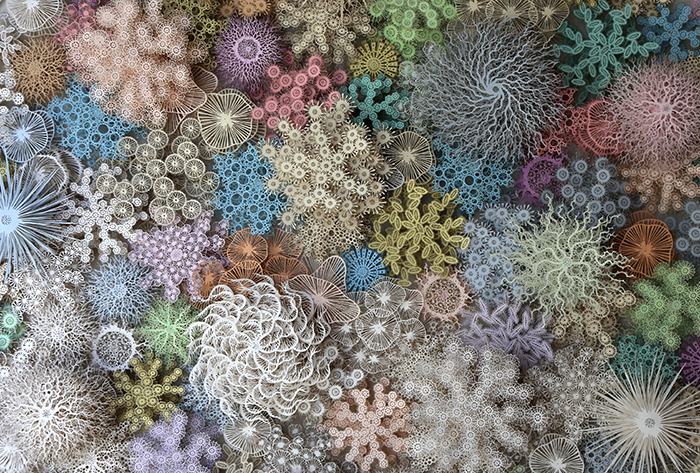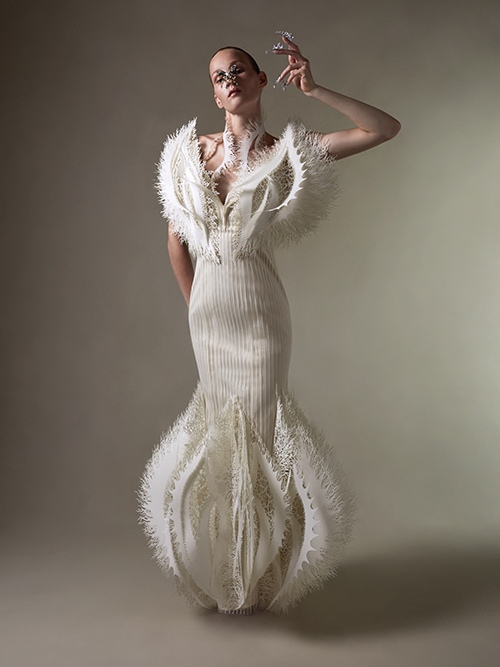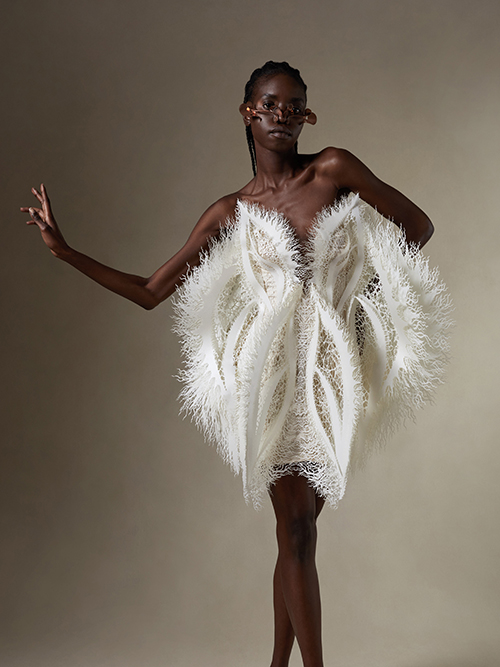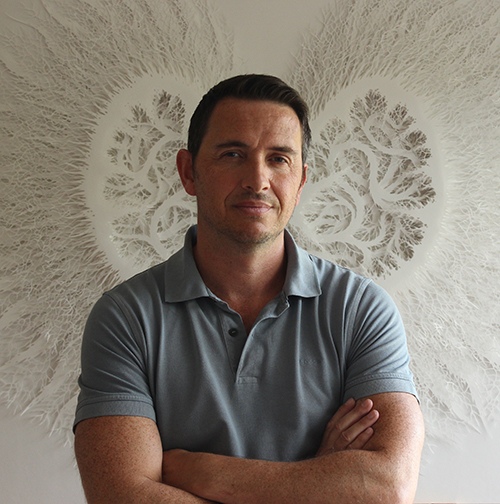
The Paper Wonders of Rogan Brown
Rogan Brown is a superb artist who has emulated the beauty and complexity of nature through his creative works on paper. His myriad of intricate paper shapes represents Rogan’s interpretation of nature – diminutive yet resilient particles make up an infinite vastness. Their gathering may seem random but they are dynamic, producing a beautiful world of coexistence.
From microbes to fashion, Rogan’s creativity has revealed the versatility in aesthetic presentations and textures of paper. Regarding himself as an outsider to our explosive-growing data-driven scientific world, Rogan brilliantly transforms his perception into magnificent art. With precision in his execution and abundant imagination, Rogan has immersed his audience in countless wonders of nature time and time again.
We are thrilled to be able to interview Rogan. His words, below, allow us to glimpse the inner world of a fine artist who has dedicated himself to embracing nature with one single medium for several decades.
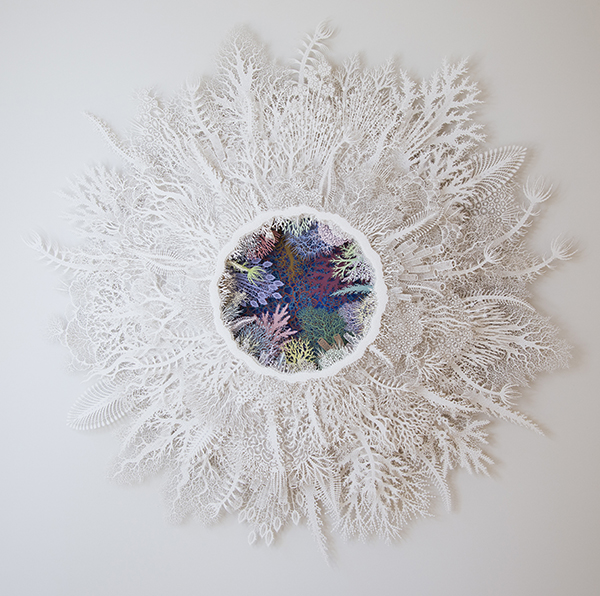
Q: Your paper sculptures are absolutely incredible. Please share with us your artistic training that built such a strong foundation for your work.
A: I am a self-taught artist who has been making art for the last 40 years.
Q: Why do you choose paper as the medium for your sculptures?
A: I was looking for a medium to capture the delicate, fragile texture of the natural world. I started experimenting with cutting paper and was astounded by its material properties, just how far it could be cut and still retain its structural integrity. As an organic material that comes from nature, it is perfect for the creation of organic natural sculptures.
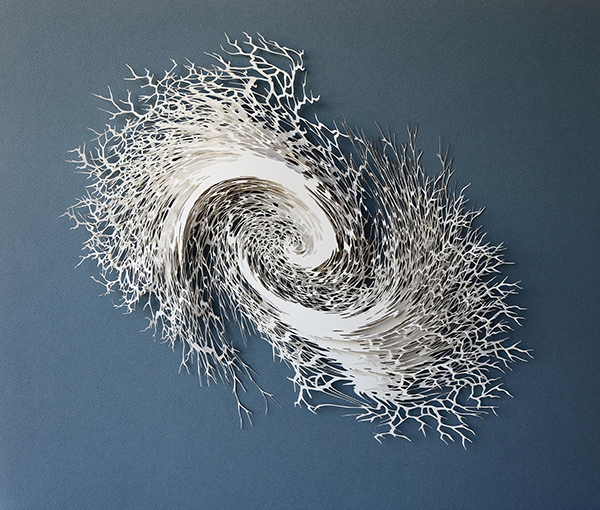
Q: You have stated that “my work comes into being in the space where science fact and science fiction meet and merge.” Please elaborate on that.
A: The work at its simplest level is about nature and the imagination and therefore I’m profoundly influenced by the Romantic tradition on the one hand and, perhaps paradoxically, by science on the other. When I started I was living in a very wild, remote rural region of France and I wanted to engage artistically with that environment. But the scale of nature is so vast and overwhelming with so much variety and detail that it was difficult to know where to start. Moreover today, thanks to science and scientific imaging technologies such as satellites or electron micrographs, we can access images of nature at every level of scale, from cell structures to galaxies in formation, adding to our knowledge but also to our confusion. Pouring over this vast quantity of visual data I began to make sense of it by identifying patterns and repeated motifs that exist in nature in different contexts and at different scales. I developed a repertoire, or rather a taxonomy, of different patterns that I then used to construct wholly imaginary organisms. This is important to me; I believe the role of the artist is to transform reality not merely to imitate or transcribe it; I solicit the recognition of the viewer but withhold it by making works that are visually ambiguous by making multiple visual references simultaneously: cell structures, microbes, marine algae, coral, vegetal forms, cloud formations, topographical maps, the body’s organs, and orifices, etc. The ultimate aim is to get people to stop, look, observe and see the beauty, intricacy, diversity and fragility of the natural world that surrounds them.
“different scales” = different levels of physical scale, going from microscopic to macroscopic; for example, a spiral structure can be seen in the formation of a galaxy as well as a snail’s shell.
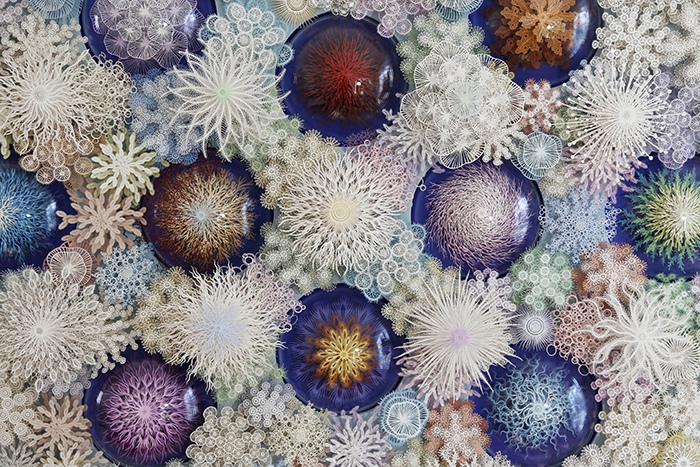
Q: The visual representations of your paper sculptures are meticulous, creative, and full of imagination. What is the major theme of your work and how did you come up with this theme?
A: How we see nature in literal and conceptual terms is the common theme that runs through my work. Our understanding of the natural world is in constant expansion thanks to science and scientific imaging technologies. Even before the technological revolution nature overwhelmed us with its unfathomable scale giving rise to the philosophy of the Sublime. How much more have we learned about the vastness of what surrounds us than Kant was aware of back in the 18th century? Science doesn’t simply mediate our perception of nature, it now completely dominates it and has altered our understanding of the very texture of the world around us. The illusion of the solidity of the physical world, including that of our own bodies, has been punctured and atomized into a cloud of ever smaller structures: cells, proteins, molecules, atoms, protons, quarks, and quantum energy fields. It is this new perception of the world that I explore in my work by attempting to find accessible visual metaphors that describe phenomena that are difficult to grasp because of their scale: infinitesimally small in size and unimaginably vast in number.
Q: If you don’t mind, please take us through the process of your work. What tools and techniques do you use in sculpting the sculptures?
A: I start by creating detailed drawings which are then vectorized and laser cut from sheets of paper. The cuts are then layered and separated by a complex structure of hand-cut cards and foam board spacers creating the illusion that each layer is floating on top of the other.
Q: Recently you veered into the fashion world. Please share with us this experience and how it differs from your original work.
A: I was contacted by Dutch avant-garde designer Iris Van Herpen to collaborate on a design for a dress. She’d been following my work for some years and taken some inspiration from it. I was ignorant of her work because I know very little about fashion but was amazed when I saw what she was doing. She’s also inspired by nature and science so a collaboration seemed like a great idea. I provided initial designs which she adapted to fit the human body and I then laser cut the materials which were made from recycled ocean plastic and textile. The results ended up on the red carpet at the Cannes Film Festival and the Met Gala; it was quite a surreal experience!
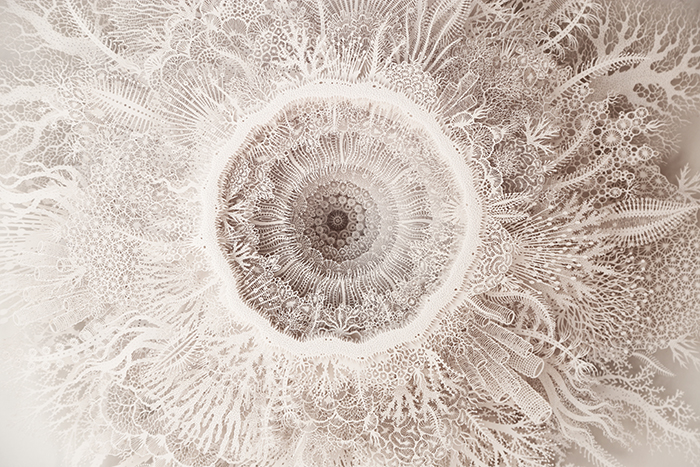
Q: Do you have any upcoming exhibitions that you would like to share with our readers?
A: I’m taking part in a large-scale group show in Venice from April 10 to May 1, 2022. This is a huge event dedicated to contemporary craftsmanship with dozens of immersive exhibitions focused on different materials including paper.
https://www.homofaber.com
I am also exhibiting work in various galleries around the world:
USA
https://seattle.winstonwachter.com
Paris, France
https://www.galeriebettina.com
Holland
https://www.gallery40.nl

